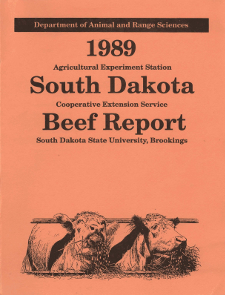Document Type
Report
Report Number
89-20
Publication Date
1989
Keywords
feedlot, survey, size, techonology, management practices, diet ingredients
Summary
During March 1989, a mail survey of South Dakota cattle feedlot managers was undertaken. The purposes of the survey were to characterize the nature of the cattle feeding industry in South Dakota and to determine the relationships between (i) each of size-of-feedlot and geographic location within the state and (ii) management practices followed by cattle feeders. Direct relationships exist between size-of-feedlot and the following: (1) rate of feedlot utilization in each quarter of the year (P<.10); (2) percentage grain relative to roughage in both growing and finishing diets (P<.10); (3) percentage of feedlots feeding high moisture grain, cracked grain, and ground hay (P<.01); (4) percentage of feedlots using rumen stimulants and growth implants (P<.01); and (5) percentages of managers testing feeds for nutrient composition, using feed scales to control feeding rates, maintaining feed records for separate pens of cattle, and hiring consultants to formulate rations (P<.01). On the other hand, inverse relationships exist between size-of-feedlot and the following: (6) days on feed for heifer calves, yearling steers, and yearling heifers (P<.10); (7) slaughter weight of steers (Pc.10); (8) percentage of home-raised hay and dry grain (P<.10); (9) percentage of feedlots feeding ground grain and unprocessed hay (P<.01); and (10) percentage of feedlots not using feed additives (P<.10). Average days on feed for steer and heifer calves are lower (P<.05) in the West than in other areas of the state. More milo is fed in the West; more barley is fed in the North Central region; and less home-raised corn silage and haylage are fed in the West than in other regions (P<.05).
Number of Pages
7
Format
application/pdf
Language
en
Publisher
South Dakota State University
Rights
Copyright © 1989 South Dakota State University
Recommended Citation
Taylor, D C.; Wagner, J. J.; and Kappes, R. D., "Feeding Practices in South Dakota Cattle Feedlots" (1989). South Dakota Beef Report, 1989. 21.
https://openprairie.sdstate.edu/sd_beefreport_1989/21


